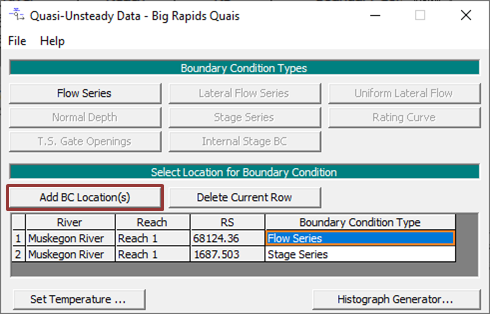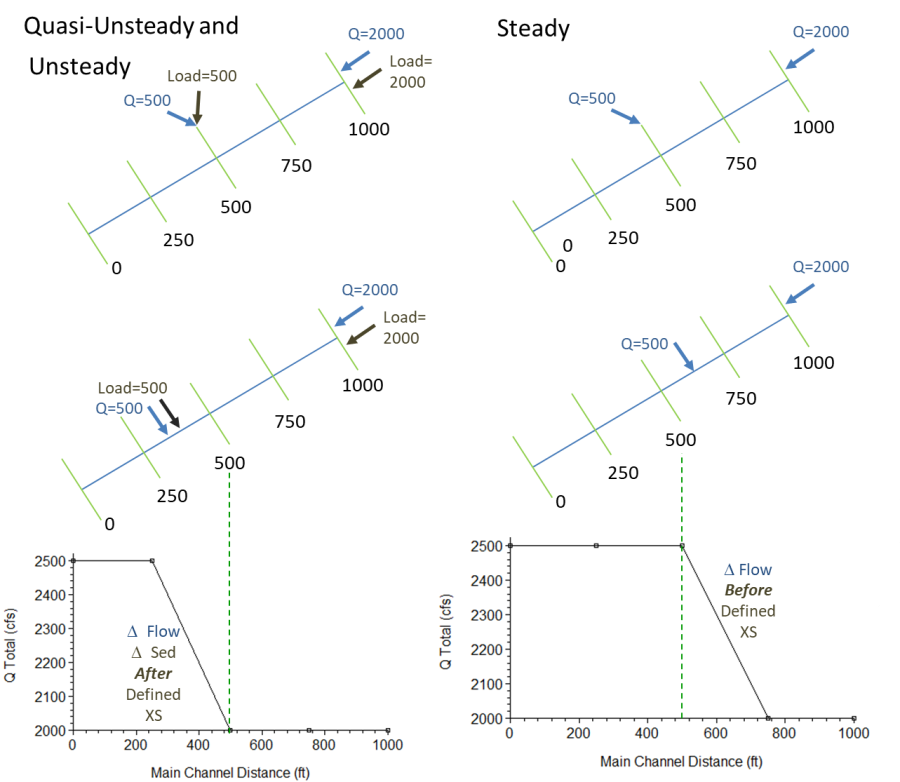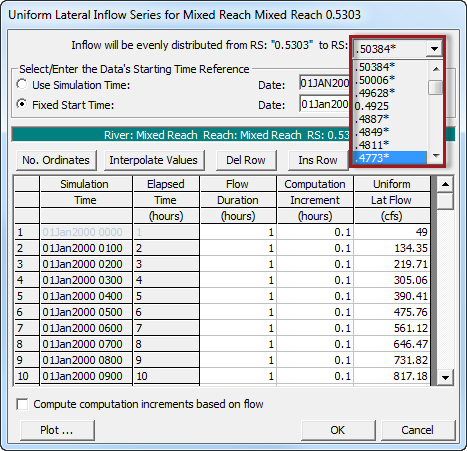Users can also define boundary conditions at internal cross sections. Internal cross sections are mostly optional (except for Gate Openings; if an inline structure has gates HEC-RAS will add it to the boundary condition editor for gate opening information).
To add an internal boundary condition press the Add BC Location(s) button (below) and specify the cross section to add. 

Lateral Flow Series
A lateral flow series can also be associated with any internal cross section in a project. This feature usually accounts for flows from un-modeled tributaries. The user must add an internal cross section to the Quasi-Unsteady Flow dialog before assigning it a quasi-unsteady boundary condition.
Add a flow change location with the Add Flow Change Location(s) button on the Quasi Unsteady Flow dialog. This will open the Select River Station Locations dialog (used elsewhere in the program e.g. Figure 1 51). Select one or more river stations by double clicking them or selecting them and pressing the arrow button. Pressing OK will create a boundary condition location for each selected station in the Quasi-Unsteady Flow Editor. The Lateral Flow Series editor is identical to the flow series editor in Upstream Boundary Conditions.
Location of Lateral Flows and Sediment Loads
Steady and Unsteady flow bring "lateral flows" (a lateral boundary condition in unsteady and a flow change location) upstream and downstream of the specified cross section respectively (below). Steady flow changes show up at the specified cross section (conceptually entering the model upstream) and unsteady lateral flow boundaries show up at the cross section downstream of the defined cross section (conceptually entering the model downstream of the control volume).
Quasi unsteady follows the unsteady flow convention Quasi-unsteady only follows the unsteady convention in more recent versions of HEC-RAS. In earlier versions, quasi-unsteady followed the steady flow convention, entering the model upstream of the specified cross sections. (despite being a series of steady flows). A Quasi-unsteady flow model will bring flow into the model downstream of the specified cross section. If a sediment rating curve is assigned to one of these lateral flow series boundary conditions, it will come in at the same location as the flow, downstream of the specified cross section (below).
Modeling Note: Locating a Tributary
Because both quasi- and unsteady flow models bring tributary flows into the model downstream of the specified cross section, define the tributary flow and load at the cross section upstream of the point where it enters the system. Conceptually, the Tributary enters the model at the transition between the two control volumes. Therefore, a model that lays out the cross sections so a tributary (modeled as a lateral flow series) enters between the cross sections will work well.

HEC-RAS can also distribute a lateral flow series over several cross sections. This feature often distributes overland watershed runoff, computed from a hydrologic model, along the hydraulic reach instead of concentrating it at one point.
Defining a uniform lateral flow follows the same steps as the lateral flow series (above). Add a lateral boundary location with the Add Flow Change Location(s) button at the cross section upstream of those HEC-RAS will distribute the flow over. Select the Uniform Lateral Flow button. The Uniform Lateral Flow button opens the editor shown below. This dialog is similar to the other flow series dialogs (Figure 1 4) with one addition, a drop down list of downstream cross sections at the top.
HEC-RAS will distribute the flow by reach weighted averages, apportioning more flow to cross sections with longer downstream channel reach lengths. Uniform lateral flows cannot be specified across stream junctions, bridges, inline or lateral structures.
